Origin
Originally conceived and tied by Frank Sawyer MBE, an English River Keeper on the Hampshire Avon in 1958, the Pheasant Tail Nymph is one of the oldest of modern nymphs. Sawyer was a friend of G. E. M. Skues, generally considered the father of modern nymph fishing and the Pheasant Tail was inspired by a fly known as the Pheasant Tail Red Spinner which seemed to catch more fished when it was submerged. [1] Skues used a soft-hackle fly with cock pheasant tail fibers for the body, but longer hackle for the legs. This fly was unweighted and rode in the top few inches of the stream with the hackle legs extended. Sawyer observed that typical mayfly nymphs floated in the stream with their legs held close to their body. The Pheasant Tail nymph was created with wire, pheasant tail fibers and short legs to get the fly deeper in the water column as well as replicate the natural appearance of typical mayfly nymph suspended in the flow. [1]
The pattern quickly became successful on trout streams in England and America as it was an excellent imitation of the nymphs of any mayfly species with olive or olive-brown bodies.
Tying the fly
Frank Sawyers' book Nymphs and the Trout first published in 1958 describes the method of tying and fishing the nymph. The design of the fly is significantly different from other flies in that Sawyer did not use thread to construct the fly, instead opting to use very fine copper wire. This has two effects; it adds weight to the fly, enabling it to be fished deeper than similar patterns (see below), and adds a subtle brightness to an otherwise drab fly. [2] [3]
Frank twisted the wire and pheasant tail fibers around one another, and wrapped them forward together, forming the thorax and abdomen. A few good variations have been developed over the years, but when you strip them away, it's still Sawyer's elegantly simple, devastatingly effective nymph.
Frank's Pheasant Tail suggests many of the skinny nymphs that flourish in various habitats, exciting riffles to alluring deep holes in the rivers bed of chalk streams or spring creeks; and in stillwaters of all sizes.
Fishing the Pheasant Tail
In streams and rivers, the Pheasant Tail can be presented below the surface if required, but it is at its most productive when allowed to sink close to the river bed on a dead drift and then gently raised in the water to imitate the behaviour of the natural insect. [4] This behaviour of the fly stimulates trout to regard the fly as natural food, and to try to eat it, at which point the hook can be set. This technique has become known as the "Induced Take", and the development of this technique may be considered to be as important as the development of the fly itself.
In chalk streams and spring creeks trout often take up station at the most advantageous feeding position. Cast upstream and allow the current to present your Pheasant Tail in a natural manner. Alternatively, cast across the stream, allow the fly to sink, and as the fly approaches the feeding trout stop the line and allow the fly to rise in the water. Watch the trout if you can, or alternatively watch the tip of the fly line for any movement and, if seen, lift the rod tip and gently set the hook.
On lakes, this is a very effective fly in the middle of the day during the Callibaetis season. Use a floating line with greased sunken leader, retrieve the fly very slowly just below the surface. Pay particular attention to shallow areas near weed beds
In the UK, Sawyer's Pheasant Tail Nymph is an excellent imitation of "agile darter" nymphs, specifically Lake Olive (Cloëon simile) and Pond Olive (Cloëon dipterum) at any time of day, and can even be used during a midge (chironomidae) hatch.

Fly fishing is an angling method that uses a light-weight lure—called an artificial fly—to catch fish. The fly is cast using a fly rod, reel, and specialized weighted line. The light weight requires casting techniques significantly different from other forms of casting. The flies may resemble natural invertebrates, bait-fish, or other food organisms.

Mayflies are aquatic insects belonging to the order Ephemeroptera. This order is part of an ancient group of insects termed the Palaeoptera, which also contains dragonflies and damselflies. Over 3,000 species of mayfly are known worldwide, grouped into over 400 genera in 42 families.

The Hare's Ear or Gold Ribbed Hare’s Ear is a traditional artificial fly imitating an aquatic insect larva (nymph) used in fly fishing.

Fly tying is the process of producing an artificial fly used by fly fishing anglers to catch fish. Fly tying is a manual process done by a single individual using hand tools and a variety of natural and manmade materials that are attached to a hook. Although the recent history of fly tying dates from the middle 1800s, fly tyers were engaged in tying flys since at least 200 AD.

The Woolly Bugger is an artificial fly commonly categorized as a wet fly or streamer and is fished under the water surface. It is a popular and widely used pattern for both freshwater and saltwater game fish and is generally listed as one of the top patterns to have in any fly box. John Gierach, a noted fly fishing writer discussed the Woolly Bugger first in his chapter on streamers in Good Flies. Woolly Buggers are typically fished in streams, rivers, ponds, lakes, and tidal flats. Today, Woolly Buggers are tied in a wide variety of styles and colors to imitate a wide range of game fish prey.
The Woolly Bugger is so effective, it should be banned from some watersheds. I suspect its effectiveness is due to its resemblance to so many edible creatures in the water—nymphs, leeches, salamanders, or even small sculpins. Its tail undulating behind a fiber, bubble-filled body is just too much for most fish to resist. It just looks like a meal!
Dry fly fishing is an angling technique in which the lure is an artificial fly which floats on the surface of the water and does not sink below it. Developed originally for trout fly fishing, it is sometimes regarded as the supreme fishing sport, owing to its difficulty in both manual dexterity and understanding of the fish in its environment.

An artificial fly or fly lure is a type of fishing lure, usually used in the sport of fly fishing. In general, artificial flies are an imitation of aquatic insects that are natural food of the target fish species the fly fishers try to catch. Artificial flies are constructed by fly tying, in which furs, feathers, thread or any of very many other materials are tied onto a fish hook.
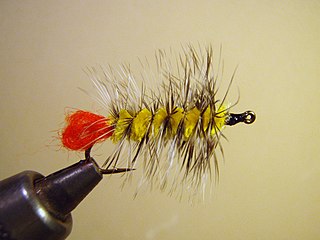
The Woolly Worm is an artificial fly commonly categorized as a wet fly or nymph and is fished under the water surface. It is a popular pattern for freshwater game fish and was a very popular fly in the 1950s–1970s in the west. Charles Brooks in Nymph Fishing for Larger Trout recommends the Woolly Worm as a general purpose nymph pattern in most western trout waters in any fly box. Woolly Worms are typically fished in streams, rivers, ponds, and lakes for trout, bass, and panfish. Today, Woolly Worms are tied in a variety of styles and colors to imitate a large aquatic nymphs such as stoneflies, dragonflies, damselflies or hellgrammites.
Frank Sawyer MBE (1906–1980) was an English riverkeeper, writer, and inventor of such flies as the Pheasant Tail Nymph. He died in 1980 on the banks of the River Avon at Netheravon.
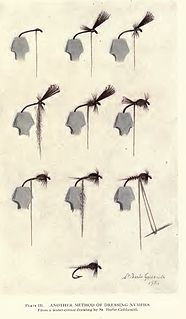
The Way of a Trout with a Fly and Some Further Studies in Minor Tactics is a fly fishing book written by G. E. M. Skues published in London in 1921. This was Skues's second book after Minor Tactics of the Chalk Stream (1910).
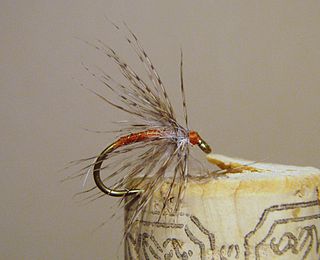
The Partridge and Orange is an artificial fly commonly categorized as a wet fly or soft hackle and is fished under the water surface. The fly is a very well known fly with its roots set firmly in English angling history. It is an impressionistic pattern fished successfully during caddis hatches and spinner falls. The Partridge and Orange is traditionally a trout and grayling pattern but may be used for other aquatic insect feeding species.
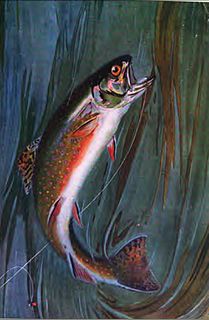
This annotated bibliography is intended to list both notable and not so notable works of English language, non-fiction and fiction related to the sport of fly fishing listed by year published. Although 100% of any book listed is not necessarily devoted to fly fishing, all these titles have significant fly fishing content. Included in this bibliography is a list of species related fly fishing literature.
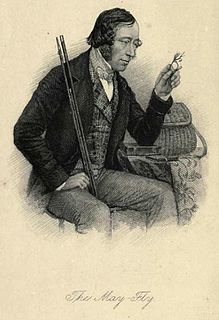
This annotated bibliography is intended to list both notable and not so notable works of English language, non-fiction and fiction related to the sport of fly fishing listed by year published. Although 100% of any book listed is not necessarily devoted to fly fishing, all these titles have significant fly fishing content. Included in this bibliography is a list of fly tying, fly tackle, regional guides, memoirs, stories and fly fishing fiction related literature.

The Elk Hair Caddis is a dry fly commonly used for trout fishing. The Elk Hair Caddis was created by Pennsylvania fly tyer Al Troth in 1957. He is considered a pioneer in the sport of fly fishing for this invention.

The Adams is a traditional dry fly primarily used for trout. It is considered a general imitation of an adult mayfly, flying caddis or midge. It was designed by Leonard Halladay from Mayfield, Michigan in 1922, at the request of his friend Charles Adams. The Adams has been considered one of the most popular, versatile, effective and best selling dry flies since its creation.
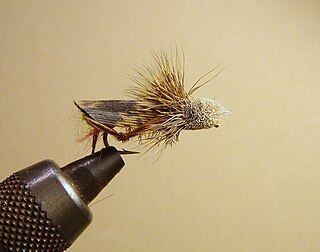
Dave's Hopper is an artificial fly used for fly fishing, designed to imitate adult grasshoppers and other Orthoptera species. It is considered a dry fly terrestrial pattern. It was designed by fly tyer and angler Dave Whitlock, and combines the best aspects of Joe's Hopper and Muddler Minnow patterns.

The Sakasa Kebari or reverse-hackle fly is an artificial fly most associated with the Japanese style of tenkara fishing but can be used in most freshwater fly fishing. The Sakasa Kebari is usually defined by firstly its reverse hackle and secondly by its simplicity as compared to western style flies. This fly was originally created to be used in the small, high gradient streams in Japan while fishing for native trout and char.

The Wulff series of dry flies evolved from a dry fly style conceived by angler Lee Wulff in the 1930s.
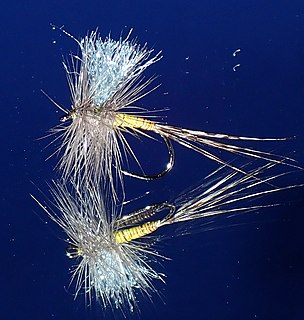
Blue-winged Olive flies is a collective term used by anglers in fly fishing to identify a broad array of mayflies having olive, olive-brown bodies and bluish wings in their adult form. Sometimes referred to as BWO , a wide array of artificial flies are tied to imitate adult, nymphal and emerging stages of the aquatic insect. While the family Baetidae probably has the most species identified as blue-winged olives, another mayfly family Ephemerellidae also contains some. Collectively, blue-winged olive mayflies are an important food source in most trout streams, thus their widespread imitation by fly tiers.

The Humpy fly is a popular and effective dry fly used by fly anglers for trout in fast-water conditions.
This page is based on this
Wikipedia article Text is available under the
CC BY-SA 4.0 license; additional terms may apply.
Images, videos and audio are available under their respective licenses.

























